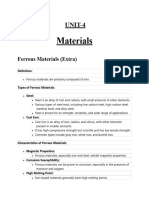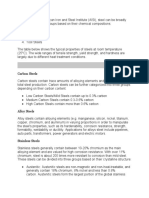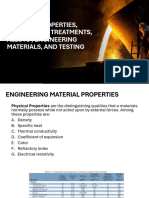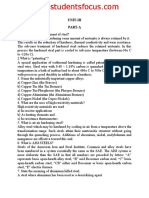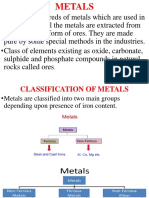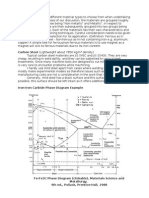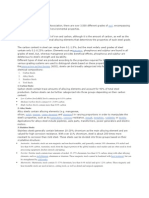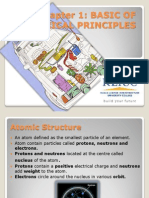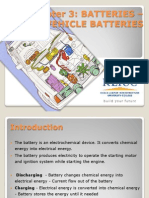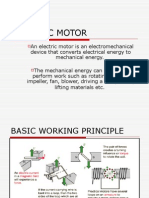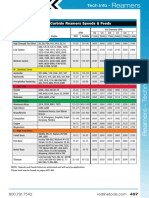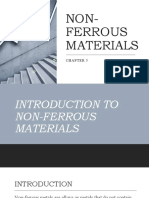Steels
Steels
Uploaded by
Asmawi Mohd KhailaniCopyright:
Available Formats
Steels
Steels
Uploaded by
Asmawi Mohd KhailaniOriginal Description:
Copyright
Available Formats
Share this document
Did you find this document useful?
Is this content inappropriate?
Copyright:
Available Formats
Steels
Steels
Uploaded by
Asmawi Mohd KhailaniCopyright:
Available Formats
Chapter 8 : Steels
Learning Objectives :
1) Name four diferent tpes of steels and! for each! cite
compositional diferences! distinctive properties! and tpical
uses"
Introduction
Based on composition, metal alloys are grouped into two classes
1) Ferrous iron is the principal constituent e.g. steels and cast iron
2) Nonferrous alloys that are not iron based
Ferrous alloys are used extensiely because!
1) "ron ores exist in abundant #uantities.
2) $conomical extraction, refining, and fabrication techni#ues are
aailable.
%) &he alloys may be tailored to hae a wide range of properties.
'isadantages of ferrous alloys are!
1) &hey are susceptible to corrosion.
2) &hey hae a relatiely high density.
%) &hey hae relatiely low electrical conductiities
Steels
(teels are iron)carbon alloys that may contain trace of other alloying
elements. (ome of common steels are classified according to carbon
concentration namely, into low), medium), and high) carbon types.
*ow +arbon (teels
,f all the different steels, low carbon steels are produced in the greatest
#uantity. &hese contain less than about -.2. wt / + and a little manganese
Properties: nonresponsie to heat treatments0 relatiely soft and
wea1 but hae outstanding ductility and toughness0 machinable and
weldable
Page 1 of 3
Typical applications: automobile body components, structural shapes
2")beams, channel and angle iron), sheets used in pipelines,
buildings, bridges, and tin cans.
High-strength, low alloy (HSLA) steels are another group of low carbon
steels. They contain other alloying eleent ( !u, ", #i, $o) as high as %&'
in cobine( concentration. HSLA steels posses higher strength, ore
corrosion resistance than plain carbon steels.
3edium +arbon (teels
4bout -.2. ) -.5- wt / +. &he plain medium)carbon steels hae low
hardenabilities. &he heat)treated medium) carbon steels contain +r, Ni and
3o to improe the capacity to heat treatment thus, improing strength)
ductility combinations. &hey are stronger than low)carbon steels
6roperties! heat treatable, relatiely large combinations of mechanical
characteristics.
&ypical applications! railway wheels and trac1s, gears, cran1shafts,
and machine parts.
7igh +arbon (teels
4bout -.5- 1.8 wt / +. &he hardest, strongest, and yet least ductile of
the carbon steels. &hey are used in a hardened and tampered condition
2wear resistance). &he tool and die steels are high carbon alloys contain
2+r, 9, :, 3o). &he combination with + will form ery hard and wear
resistance carbide compound 2for cutting tools).
6roperties! hard, strong, and relatiely brittle.
&ypical applications! chisels, hammers, 1nies, and hac1saw blades.
7igh 4lloy (teels ;(tainless steel
&he ma<or alloying element is +r = 11wt/. +orrosion resistant is enhanced
by adding Ni and 3o
6roperties! hard and wear resistant0 resistant to corrosion in a large
ariety of enironments.
&ypical applications! cutting tools, drills, cutlery, food processing, and
surgical tools
Page 2 of 3
Page 3 of 3
You might also like
- SS Ni LiteDocument114 pagesSS Ni Litepaeg6512No ratings yet
- Carbon & Alloy Steels Nomenclatura AISI SAEDocument51 pagesCarbon & Alloy Steels Nomenclatura AISI SAEbs2002No ratings yet
- Ferrous and Non-Ferrous Metals: Intended Learning OutcomesDocument83 pagesFerrous and Non-Ferrous Metals: Intended Learning OutcomesJingness StanNo ratings yet
- Engineering Materials I Notes 2022 METALSDocument15 pagesEngineering Materials I Notes 2022 METALSAliciaNo ratings yet
- Ferrous & Non-Ferrous AlloysDocument22 pagesFerrous & Non-Ferrous AlloysHarsh V Ashok0% (1)
- PQT Chapter 11 Applications and Processing of Metal AlloysDocument30 pagesPQT Chapter 11 Applications and Processing of Metal AlloysNguyễn Việt TiếnNo ratings yet
- CH 01Document60 pagesCH 01tazebNo ratings yet
- Metals: Types of Metals AlloysDocument9 pagesMetals: Types of Metals AlloysIslam ElhabsheNo ratings yet
- (Simple) Alloy Steels and Cast IronDocument30 pages(Simple) Alloy Steels and Cast IronAbdo siyedNo ratings yet
- MSM Unit 4 Chap 2 (Ferrous Materials and Non-Ferrous Materials)Document15 pagesMSM Unit 4 Chap 2 (Ferrous Materials and Non-Ferrous Materials)rakeshpatkar332No ratings yet
- UNIT 2 PPT 1Document42 pagesUNIT 2 PPT 1neha yarrapothuNo ratings yet
- Lecture On Material of ConstructionDocument19 pagesLecture On Material of Constructiondeepankar kumarNo ratings yet
- All Learnig Outcomes For Exit ExamDocument326 pagesAll Learnig Outcomes For Exit ExamkhadarswggyNo ratings yet
- Jerimae J. Casio BCHE111Document6 pagesJerimae J. Casio BCHE111qwertyNo ratings yet
- Carbon SteelsDocument7 pagesCarbon SteelsRickle Vincent PilongoNo ratings yet
- Cuestionario Materiales PDFDocument19 pagesCuestionario Materiales PDFJuan Diego CalderonNo ratings yet
- Steel and Steel Making: Samantha Sarah /2006517713Document9 pagesSteel and Steel Making: Samantha Sarah /2006517713SAMANTHA SARAH PURBANo ratings yet
- Carbon SteelDocument9 pagesCarbon SteelArfanAliNo ratings yet
- Ferrous and Non Ferrous MetalsDocument3 pagesFerrous and Non Ferrous MetalsTalle Gabua100% (1)
- Types of Metals and Their Uses (With Pictures)Document10 pagesTypes of Metals and Their Uses (With Pictures)Iman SadeghiNo ratings yet
- Ferrous Metals and Alloys: (26 Marks)Document10 pagesFerrous Metals and Alloys: (26 Marks)Abhinav SharmaNo ratings yet
- Ferrous Metals and AlloysDocument44 pagesFerrous Metals and AlloysLeonardDacaymatNo ratings yet
- Thesis 35Document26 pagesThesis 35Md. Sayem ShahriarNo ratings yet
- MetalsDocument112 pagesMetalsArhum KidwaiNo ratings yet
- UNIT - III (Non Ferrous Alloys)Document4 pagesUNIT - III (Non Ferrous Alloys)Siva GaneshNo ratings yet
- BT4 Metal - Acdio - RSW1Document29 pagesBT4 Metal - Acdio - RSW1franiancis0922No ratings yet
- Microstructure Study of Ferrous and Non Ferrous Alloys Under Various Compositions and Heat Treatment Conditions Lab ReportDocument7 pagesMicrostructure Study of Ferrous and Non Ferrous Alloys Under Various Compositions and Heat Treatment Conditions Lab Reportzrro50% (4)
- Unit 3 PDFDocument25 pagesUnit 3 PDFharshitha2005sriNo ratings yet
- Tcbe 1202-3 MetalsDocument15 pagesTcbe 1202-3 MetalsshafikNo ratings yet
- Material Properties Metals Heat Treatments Alloys Engineering Materials and TestingDocument62 pagesMaterial Properties Metals Heat Treatments Alloys Engineering Materials and TestingAnn NavarroNo ratings yet
- CEM Unit 4-1Document52 pagesCEM Unit 4-1kunalsharmaa2929No ratings yet
- Metals and AlloysDocument34 pagesMetals and AlloyszenrockNo ratings yet
- Metals (Ferrous Non Ferrous Material)Document16 pagesMetals (Ferrous Non Ferrous Material)airy orzagaNo ratings yet
- Unit 4 Answers FinalDocument14 pagesUnit 4 Answers FinalAditya BishtNo ratings yet
- IRONDocument19 pagesIRONPadmaja RathNo ratings yet
- R20 Advance Materials NotesDocument116 pagesR20 Advance Materials NotesPraveen 007No ratings yet
- MEE 511 Course WorkDocument10 pagesMEE 511 Course WorktornakingstonNo ratings yet
- Ferrous and Non-Ferrous Metals: Group 5Document37 pagesFerrous and Non-Ferrous Metals: Group 5Morel TalekeudjeuNo ratings yet
- UntitledDocument15 pagesUntitledkushagra agrawalNo ratings yet
- Lecture 2 - ECE 2215 PDFDocument24 pagesLecture 2 - ECE 2215 PDFRando ClintonNo ratings yet
- Lec 02Document19 pagesLec 02أمير حامد100% (1)
- TVET 1 (Info. Sheet 6)Document3 pagesTVET 1 (Info. Sheet 6)John Lester GinoNo ratings yet
- Ferrous Materials: Gujarat Power Engineering and Research Institute Active Learning AssesmentDocument20 pagesFerrous Materials: Gujarat Power Engineering and Research Institute Active Learning AssesmentravijecrcNo ratings yet
- Lec-8 - Metallurgy PDFDocument16 pagesLec-8 - Metallurgy PDFGhaith MdljNo ratings yet
- Metallurgical Engineering - MATERIAL STEEL: CLASSIFICATIONS, GRADES AND PDocument8 pagesMetallurgical Engineering - MATERIAL STEEL: CLASSIFICATIONS, GRADES AND PSandeep PrajapatiNo ratings yet
- GCE3135 AssignmentDocument10 pagesGCE3135 AssignmentBilal MishoryNo ratings yet
- Unit-Iii Part-ADocument6 pagesUnit-Iii Part-AParameswara RajaNo ratings yet
- Material EngineeringDocument46 pagesMaterial EngineeringBoaquin Khen100% (1)
- Classification of Steel PDFDocument11 pagesClassification of Steel PDFkart_rl100% (2)
- MZ FS Unit - 1Document27 pagesMZ FS Unit - 1Jai KumarNo ratings yet
- Ferrous Non Ferrous Ceramics 2Document45 pagesFerrous Non Ferrous Ceramics 2salayonmarife10No ratings yet
- 202 Out1Document5 pages202 Out1professorNo ratings yet
- METALSDocument48 pagesMETALSMian Afzaal 72No ratings yet
- Chem 114 Metals 1Document44 pagesChem 114 Metals 1Elein MarceloNo ratings yet
- MaterialsDocument5 pagesMaterialsSurarak PakornmanokulNo ratings yet
- Steel: 1) Carbon SteelsDocument2 pagesSteel: 1) Carbon SteelsPriyanathan ThayalanNo ratings yet
- Lab 2 MaterialDocument22 pagesLab 2 MaterialMon LuffyNo ratings yet
- Carbon in SteelDocument8 pagesCarbon in SteelJanice FernandezNo ratings yet
- Chapter 1 Ferrous CharacteristicsDocument69 pagesChapter 1 Ferrous CharacteristicsTuan VuNo ratings yet
- Chapter7 - Metalandalloy ScienceDocument19 pagesChapter7 - Metalandalloy Scienceshakirr aimannNo ratings yet
- Presented By, Shah Meet A. Civil-Sem1 ENROLLMENT NO 131080106054Document16 pagesPresented By, Shah Meet A. Civil-Sem1 ENROLLMENT NO 131080106054Umesh PradhanNo ratings yet
- Failure of MetalsDocument15 pagesFailure of MetalsAsmawi Mohd KhailaniNo ratings yet
- Properties of Pure Substances: Thermodynamics: An Engineering ApproachDocument35 pagesProperties of Pure Substances: Thermodynamics: An Engineering ApproachAsmawi Mohd KhailaniNo ratings yet
- Chap 1 ThermodynamicsDocument41 pagesChap 1 ThermodynamicsAsmawi Mohd KhailaniNo ratings yet
- Properties of Pure Substances: Thermodynamics: An Engineering ApproachDocument35 pagesProperties of Pure Substances: Thermodynamics: An Engineering ApproachAsmawi Mohd KhailaniNo ratings yet
- Battery: Theory and PracticeDocument23 pagesBattery: Theory and PracticeAsmawi Mohd KhailaniNo ratings yet
- 2) Basic of ElectricityDocument20 pages2) Basic of ElectricityAsmawi Mohd KhailaniNo ratings yet
- CHAPTER 1 - Basic Electrical PrinciplesDocument42 pagesCHAPTER 1 - Basic Electrical PrinciplesAsmawi Mohd KhailaniNo ratings yet
- CHAPTER 3 - Batteries - Vehicle BatteriesDocument60 pagesCHAPTER 3 - Batteries - Vehicle BatteriesAsmawi Mohd Khailani100% (1)
- Electrical MotorDocument23 pagesElectrical MotorAnik73% (11)
- Electrical MotorDocument23 pagesElectrical MotorAnik73% (11)
- Ignition SystemDocument10 pagesIgnition SystemParag100% (1)
- GS PVV 143Document10 pagesGS PVV 143ahmadNo ratings yet
- Steel Chemical AnalysisDocument4 pagesSteel Chemical AnalysisAries Falag-eyNo ratings yet
- 7T04 MP 00 Po 041 1 B 010 - Welding - Repair - Procedure - C2 - CDocument11 pages7T04 MP 00 Po 041 1 B 010 - Welding - Repair - Procedure - C2 - CRamy OmarNo ratings yet
- Trim Chart API 600Document2 pagesTrim Chart API 600Ercan YilmazNo ratings yet
- Ingot ManufacturerDocument14 pagesIngot ManufacturerpetalsinfotechpvtltdNo ratings yet
- Macho Laminador: M DIN 13. ISO 724/965.1 MF DIN 13. ISO 724/965.1 MF DIN 13. ISO 724/965.1 Unc Asme B1.1Document2 pagesMacho Laminador: M DIN 13. ISO 724/965.1 MF DIN 13. ISO 724/965.1 MF DIN 13. ISO 724/965.1 Unc Asme B1.1emerson.mineiro100% (1)
- Bacolod - Clarence - Act 9Document4 pagesBacolod - Clarence - Act 9BACOLOD, CLARENCE JASMIN.No ratings yet
- ST 37-2 Steel, ST 37-2 Structure Steel, ST 37-2 Equivalent-Seed SteelDocument1 pageST 37-2 Steel, ST 37-2 Structure Steel, ST 37-2 Equivalent-Seed SteelPeddi Raja MohanNo ratings yet
- Publication 4 11889 199Document9 pagesPublication 4 11889 199Mulia AridhoNo ratings yet
- L7 - Fe-C - DiagramDocument41 pagesL7 - Fe-C - DiagramJnurmatovNo ratings yet
- GS PVV 144Document9 pagesGS PVV 144ahmadNo ratings yet
- Aceros SISA Tabla Norton Piedras de RectificadoDocument1 pageAceros SISA Tabla Norton Piedras de Rectificadogeav25653855No ratings yet
- Osawa Catalogue 2021Document708 pagesOsawa Catalogue 2021lorenzo.lima1706No ratings yet
- HSS Carbide Reamers Speeds Feeds p497 498Document2 pagesHSS Carbide Reamers Speeds Feeds p497 498Ravi DahiwalaNo ratings yet
- Steel: Iron AlloyDocument14 pagesSteel: Iron AlloySiva BhaskarNo ratings yet
- Elts Phases v10Document4 pagesElts Phases v10Javad MousavyNo ratings yet
- En10025 S355JRDocument2 pagesEn10025 S355JRananda_beloshe75100% (1)
- Non Ferrous MaterialsDocument87 pagesNon Ferrous MaterialsKenlie Yarzo CapagalanNo ratings yet
- Fdocuments - in - Jindal Steel Product Catalogue - MergeDocument62 pagesFdocuments - in - Jindal Steel Product Catalogue - MergephanikrishnabNo ratings yet
- Defect IIWDocument3 pagesDefect IIWPPMNo ratings yet
- Astm F836M 1997Document6 pagesAstm F836M 1997Jesse ChenNo ratings yet
- ASTM Cross Reference Material SpecificationDocument1 pageASTM Cross Reference Material SpecificationAgniva DuttaNo ratings yet
- Steel Sheet, Zinc-Coated (Galvanized) or Zinc-Iron Alloy-Coated (Galvannealed) by The Hot-Dip ProcessDocument13 pagesSteel Sheet, Zinc-Coated (Galvanized) or Zinc-Iron Alloy-Coated (Galvannealed) by The Hot-Dip ProcessAnuragNo ratings yet
- Continuously Hot-Dip Coated Steel Flat Products - Technical Delivery ConditionsDocument40 pagesContinuously Hot-Dip Coated Steel Flat Products - Technical Delivery ConditionsReginaldo SantosNo ratings yet
- Bolt Depot - Bolt Grade Markings and Strength ChartDocument2 pagesBolt Depot - Bolt Grade Markings and Strength ChartSandeep SNo ratings yet
- Section II Par T A Fer Rous Material Specifications Sa 451 To End 2019 Asme Boiler and Pressure Vessel Code An International Code PDF Free - 50Document1 pageSection II Par T A Fer Rous Material Specifications Sa 451 To End 2019 Asme Boiler and Pressure Vessel Code An International Code PDF Free - 50洛霖No ratings yet
- Metals and Alloys - DensitiesDocument2 pagesMetals and Alloys - DensitiesAnonymous KTQZaINo ratings yet
- WELDING ConsumableDocument12 pagesWELDING ConsumableMuhammad Fitransyah Syamsuar Putra100% (2)









